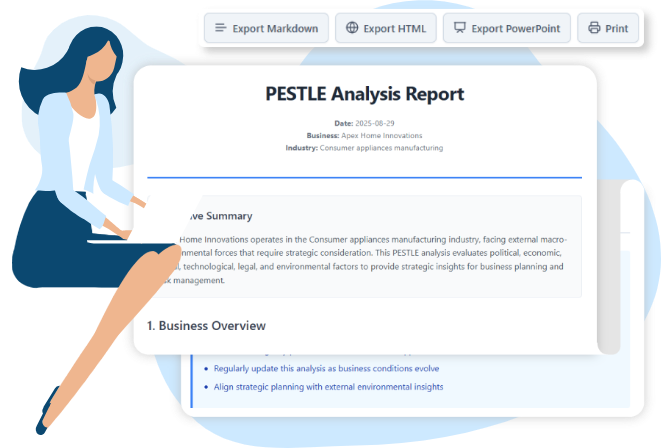Now Reading: How It Works – PESTLE Analysis Tool
-
01
How It Works – PESTLE Analysis Tool
This app is a tool for conducting a PESTLE analysis, a powerful framework used to assess the external macro-environmental factors that can impact an organization. By systematically analyzing these six areas, you can gain a deeper understanding of the opportunities and threats facing your business, helping you make more informed strategic decisions.

How it Works: From Data to Decision
Our tool is designed to guide you through a structured analysis, transforming raw data into a comprehensive strategic report. It isn’t just a place to fill in tables; it’s a digital workspace that helps you organize your research and visualize its impact.
1. Gather Your Information
Our tool is designed to guide you through a structured analysis, transforming raw data into a comprehensive strategic report. It isn’t just a place to fill in tables; it’s a digital workspace that helps you organize your research and visualize its impact.

Stakeholder Interviews
Talk to key people in your organization. Ask your marketing team about social trends, your legal team about new regulations, and your finance department about economic forecasts.
PRO TIPS: Ask open-ended questions like “What major trends are you seeing in our industry?” or “Are there any upcoming regulations that we should be concerned about?” to encourage detailed responses.

Team Workshops
Host a session with key personnel to brainstorm and discuss the external factors you’ve identified. This collaborative approach ensures a comprehensive and accurate analysis.
PRO TIPS: Use techniques like mind mapping to visually organize ideas and ensure all PESTLE categories receive attention.

External Research
Supplement your findings with data from credible sources like government reports, industry publications, and market research firms.
PRO TIPS: Prioritize credible sources such as government statistics agencies (e.g., Bureau of Labor Statistics), academic journals, and reputable market research firms (e.g., Gartner, Forrester, Nielsen).
Once you have gathered information, this tool provides a structured way to document and analyze it. This is where it excels over a simple spreadsheet. Our interface ensures consistency and forces you to consider the real-world impact of each factor.
- Political
- Economic
- Social
- Technological
- Legal
- Environmental
After you’ve completed all six sections, you can generate a Final Report. This is the key deliverable that goes beyond the data tables to provide a cohesive, actionable document that synthesizes your findings.
Business Overview
A summary of your business, its products, and its market.
Detailed PESTLE Analysis
The organized data you entered, presented in a clear, easy-to-read format.
Strategic Position
A crucial summary that synthesizes your findings to give you a holistic view.
Actionable Insights
Sections to outline strategic implications and recommendations.
This final report is not just a summary of your data entry—it’s a tool for strategic planning.
Frequently Asked Questions
What is the primary goal of a PESTLE analysis?
The primary goal is to identify and analyze the key external macro-environmental factors (Political, Economic, Social, Technological, Legal, and Environmental) that can have an impact on an organization. This helps in strategic planning, risk management, and capitalizing on opportunities.
How often should I conduct a PESTLE analysis?
It’s generally recommended to conduct a PESTLE analysis regularly, such as annually or whenever there is a significant change in the external environment. For businesses in fast-changing industries, more frequent reviews (e.g., semi-annually or quarterly) may be necessary.
Can this tool be used for any industry?
Yes, the PESTLE framework is versatile and can be applied to any industry, from technology and healthcare to retail and manufacturing. The specific factors will vary, but the process of analysis remains the same.
What's the difference between PESTLE and SWOT analysis?
PESTLE analysis focuses solely on external macro-environmental factors. SWOT analysis, on the other hand, is broader and examines both internal factors (Strengths and Weaknesses) and external factors (Opportunities and Threats). The findings from a PESTLE analysis can be used to inform the Opportunities and Threats sections of a SWOT analysis.

